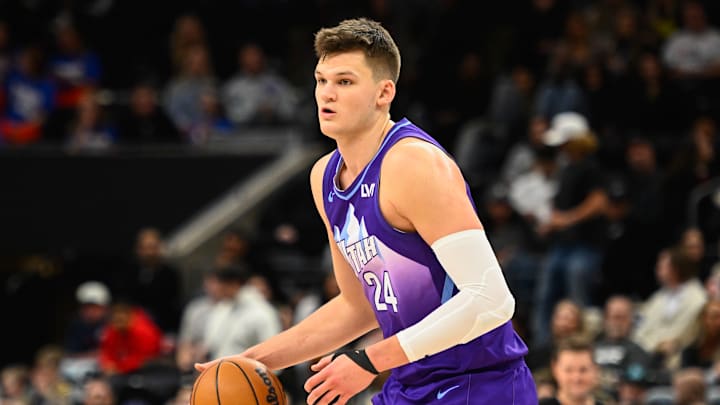The Utah Jazz's season is coming to an end, and they will finish up as one of the worst teams in the NBA. So, when they try experiments like letting Walker Kessler shoot threes, the rationale is simple.
Why not?
The Jazz have Walker Kessler, their bruising 7-footer, spamming 3s all game.
— BricksCenter (@BricksCenter) March 24, 2025
This is NEXT LEVEL tanking 😭 pic.twitter.com/PHnBSrWBc7
When a tanking team has nothing to lose in the present and plenty to gain in the future, these experiments are worth trying out because absolutely nothing can go wrong.
Sure, the results have been nothing short of bad to start, which could be concerning in the long term, but it seems the Jazz will cross that bridge when they come to it. More importantly, if Kessler adds this to his arsenal, it makes him a more unique player, which could make the Jazz even more dangerous long-term.
Why experiments like these are worth it
Even if these experiments could pay off, that doesn't make it easy to watch. The Athletic's Fred Katz explained the growing pains of seeing Kessler try to extend his range.
"Big men learning to shoot jumpers normally takes a slow buildup. They knock in a few shots from the corners, then extend to the wings. Once they refine stand-still catch-and-shoots, they can do it after movement. But Kessler is skipping the steps.
"The Jazz get him 3s in pick-and-pops and in transition. They’ll find him when he’s hanging around the perimeter, which he does more of now. The man is not simply parking in the corners. Of these 27 3-pointers, 21 have come from the wings or the top of the key. He must work on his legs, too. Fourteen of his 23 misses have fallen short," Katz wrote.
Kessler has not given any indication that he's making immediate progress as a floor spacer, but it's not like the pressure is currently on him to become just that right away. Katz also explained why Kessler's growing pains are worth it for the Jazz, both currently and long-term.
"But this is the beauty of experimentation. Pull a player out of his usual mold to encourage an unexpected skill. For all we know, three years from now, Kessler will be draining corner 3s and point to this stretch as the catalyst for his long-range competence. Plus, the Jazz get some sweet, sweet losses in the process," Katz wrote.
Some big men can protect the rim, but there aren't that many who can patrol the paint like Kessler. Some big men can space the floor enough to be considered a threat. Kessler is nowhere near that level, and it may be a while before he ever approaches it if he ever approaches it.
However, keep this in mind. Even though stretch bigs are becoming more commonplace in the NBA these days, it's rare to see them become elite defenders too. Lauri Markkanen and Kyle Filipowski will likely always be better floor spacers than Kessler, but they will never be in contention to make an All-Defense team.
The likelihood isn't great overall, but Kessler is more likely to develop a three-point shot than Markkanen or Filipowski to become good rim protectors because the latter skill is instinct more than anything.
If Kessler can find his groove from the three-point line in the coming years, he can become one of the very few hybrid two-way big men who can make a major difference on both sides of the floor in the modern game. It's very hard to find players who can make that level of impact on offense and defense.
Among the very few are Al Horford and Kristaps Porzingis, the most important big men on the reigning NBA champions. That's pretty demonstrative of what Kessler adding a three-point shot to his arsenal could do for the Jazz.
